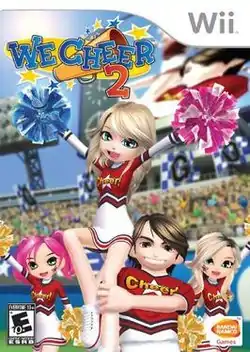We Cheer 2
We Cheer 2, known in Japan as We Cheer: Dancing Spirits! (ウィーチア ダンシングスピリッツ!), is a dance video game releases by Namco Bandai Games. It is the sequel to We Cheer.
| We Cheer 2 | |
|---|---|
 | |
| Developer(s) | Bandai Namco Studios |
| Publisher(s) | Namco Bandai Games |
| Platform(s) | Wii |
| Release | |
| Genre(s) | Dance game |
| Mode(s) | Single-player, Multiplayer |
Gameplay
The gameplay is the same as the original We Cheer using the Wii Remote as a virtual pom-poms. In the single player mode, players can use either two Wii Remotes (one in each hand) or one Wii Remote (in either the left or right hand) to follow the on-screen motions. The game also offers cooperative and competitive modes for up to 4 players. New to the game are further customization of characters and the ability to play as a male or female cheerleader.[1]
Development
The game features 30 licensed music tracks.[2]
Reception
| Aggregator | Score |
|---|---|
| Metacritic | 64/100[3] |
| Publication | Score |
|---|---|
| Famitsu | 30/40[4] |
| GamePro | |
| GameRevolution | C−[6] |
| IGN | 6.5/10[7] |
| Nintendo World Report | 8.5/10[8] |
The game received "mixed" reviews according to the review aggregation website Metacritic.[3] In Japan, Famitsu gave it a score of one eight, two sevens, and one eight for a total of 30 out of 40.[4]
References
- "NAMCO BANDAI GAMES ANNOUNCES WE CHEER™2 FOR Wii™". Namco Bandai Games. April 29, 2009. Archived from the original on January 1, 2010. Retrieved June 13, 2015.
- "NAMCO BANDAI GAMES ANNOUNCES FULL ROSTER OF SONGS FOR WE CHEER™2 for Wii™". Namco Bandai Games. Archived from the original on March 2, 2010. Retrieved June 13, 2015.
- "We Cheer 2 for Wii Reviews". Metacritic. Retrieved June 30, 2016.
- "July 7, 2010 (Famitsu scores)". The MagicBox. July 7, 2010. Retrieved June 30, 2016.
- Koehn, Aaron (November 24, 2009). "We Cheer 2". GamePro. Archived from the original on December 5, 2009. Retrieved July 1, 2016.
- Kevin S. (January 6, 2010). "We Cheer 2 Review". Game Revolution. Retrieved July 1, 2016.
- Ahearn, Nate (November 6, 2009). "We Cheer 2 Review". IGN. Retrieved July 1, 2016.
- Hernandez, Pedro (December 9, 2009). "We Cheer 2". Nintendo World Report. Retrieved July 1, 2016.